
Gesneriaceae, the gesneriad family, is a family of flowering plants consisting of about 152 genera and ca. 3,540 species in the tropics and subtropics of the Old World and the New World, with a very small number extending to temperate areas. Many species have colorful and showy flowers and are cultivated as ornamental plants.

Cephalotus is a genus which contains one species, Cephalotus follicularis the Albany pitcher plant, a small carnivorous pitcher plant. The pit-fall traps of the modified leaves have inspired the common names for this plant, which include 'Albany pitcher plant", "Western Australian pitcher plant", "Australian pitcher plant", or "fly-catcher plant." It is an evergreen herb that is endemic to peaty swamps in the southwestern corner of Western Australia.
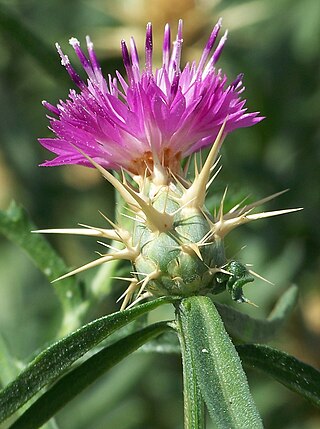
Centaurea calcitrapa is a species of flowering plant known by several common names, including red star-thistle and purple star thistle. It is native to Europe but is rarely found there, it is known across the globe as an introduced species and often a noxious weed. The species name calcitrapa comes from the word caltrop, a type of weapon covered in sharp spikes.

Armatocereus is a genus of mostly tree-like cacti from South America. These species have a conspicuous constriction at the end of the annual growth. The flowers are mostly white, with a more or less spiny ovary. The fruits are mostly spiny.
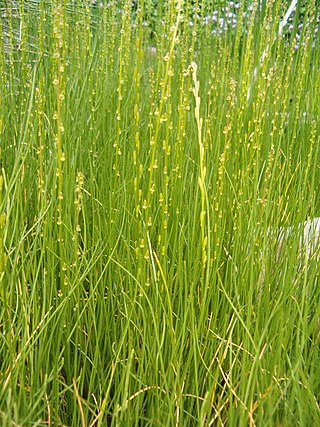
Triglochin is a plant genus in the family Juncaginaceae described by Carl Linnaeus in 1753. It includes 25 known species. It is very nearly cosmopolitan in distribution, with species on every continent except Antarctica. North America has four accepted species, two of which can also be found in Europe: Triglochin palustris and Triglochin maritima. Australia has many more.

Juncaginaceae is a family of flowering plants, recognized by most taxonomists for the past few decades. It is also known as the arrowgrass family. It includes 3 genera with a total of 34 known species.

Eucalyptus macrocarpa, commonly known as mottlecah, is a species of mallee that is endemic to the south-west of Western Australia. It has smooth bark, usually sessile, heart-shaped adult leaves arranged in opposite pairs, large red flowers and broad conical fruit.

Medicosma is a genus of shrubs and trees in the family Rutaceae, all native to New Guinea, Australia or New Caledonia. They usually have simple leaves arranged in opposite pairs, flowers arranged in cymes with four sepals, four petals and eight stamens. The fruit is a follicle fused at the base in groups of up to four, each containing one or two brown or black seeds.

Oreostylidium is a genus of flowering plants in the family Stylidiaceae with a single species, Oreostylidium subulatum, that is endemic to New Zealand. O. subulatum is a very small plant with small, white flowers. It has a complicated botanical history that has led to a few proposals to move Oreostylidium to the related genus Stylidium. The researchers cite molecular data and suspect that this species is an extreme example of floral paedomorphosis. This would not be an unprecedented move since the single species was initially described as Stylidium subulatum in 1864 and later moved to its own genus by Sven Berggren in 1878. It possesses the same kind of glandular trichomes underneath the flower that make Stylidium species carnivorous plants, but it has not yet been tested for the presence of digestive enzymes.
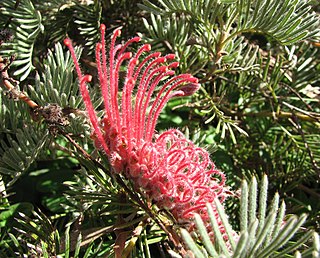
Grevillea thyrsoides is a species of flowering plant in the family Proteaceae, and is endemic to the southwest of Western Australia. It is a small, spreading or low-lying shrub, with pinnatisect to comb-like leaves, the end lobes linear, and clusters of hairy pinkish-red flowers.

Forstera bellidifolia, the Tasmanian forstera, is a species in the family Stylidiaceae that is endemic to Tasmania, Australia. It was described by William Jackson Hooker in an 1851 volume of Icones Plantarum. It is notably different from other members of the genus in that it is not native to New Zealand nor does it possess the epigynous nectaries that are present in the other species.
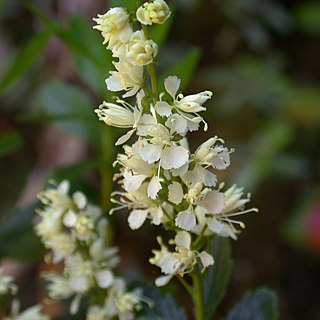
Tetracarpaea is the only genus in the flowering plant family Tetracarpaeaceae. Some taxonomists place it in the family Haloragaceae sensu lato, expanding that family from its traditional circumscription to include Penthorum and Tetracarpaea, and sometimes Aphanopetalum as well.
Persoonia rufiflora is a species of flowering plant in the family Proteaceae and is endemic to the south-west of Western Australia. It is an erect, sometimes spreading shrub with hairy young branchlets, lance-shaped to linear leaves, and hairy, greenish yellow flowers arranged singly or in pairs.
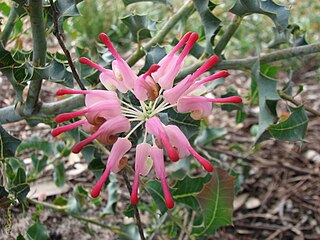
Grevillea insignis, commonly known as wax grevillea, is a species of flowering plant in the family Proteaceae and is endemic to the south-west of Western Australia. It is an erect, bushy shrub with more or less oblong leaves with seven to seventeen sharply-pointed, triangular teeth, and more or less spherical or cylindrical clusters of cream-coloured flowers ageing to pink.

Dicrastylis is a genus of plants in the Lamiaceae, first described in 1855. The entire genus is endemic to Australia. The type species is Dicrastylis fulva.
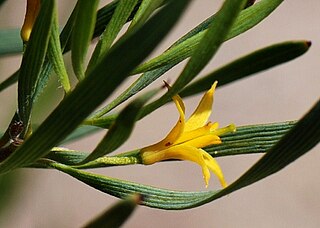
Persoonia quinquenervis is a species of flowering plant in the family Proteaceae and is endemic to the south-west of Western Australia. It is an erect, spreading shrub with hairy young branchlets, twisted linear, lance-shaped, narrow oblong or narrow spatula-shaped leaves, and bright yellow flowers borne in groups of up to ten on a rachis up to 60 mm (2.4 in) that continues to grow after flowering.

Pterodiscus is a genus of plant in the Pedaliaceae family comprising several species with a native range from Ethiopia to S. Africa. The range passes through the countries of Angola, Botswana,, Ethiopia, Kenya, Mozambique, Namibia, Somalia, Sudan, Tanzania, Zambia and Zimbabwe. Plus it is found also within the Provinces of South Africa in Cape Provinces, Free State, KwaZulu-Natal and Northern Provinces.

Baeckea leptocaulis is a species of flowering plant in the family Myrtaceae and is endemic to Tasmania. It is a shrub with linear leaves and small white flowers with five or six stamens.
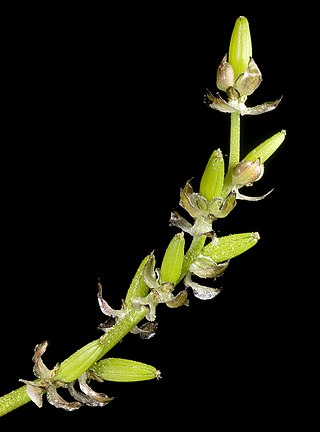
Triglochin muelleri is a species of flowering plant in the family Juncaginaceae, first described by Franz Georg Philipp Buchenau in 1903, and native to Western Australia and South Australia.

Quercus subgenus Cerris is one of the two subgenera into which the genus Quercus was divided in a 2017 classification. It contains about 140 species divided among three sections. It may be called the Old World clade or the mid-latitude clade; all species are native to Eurasia and North Africa.



















